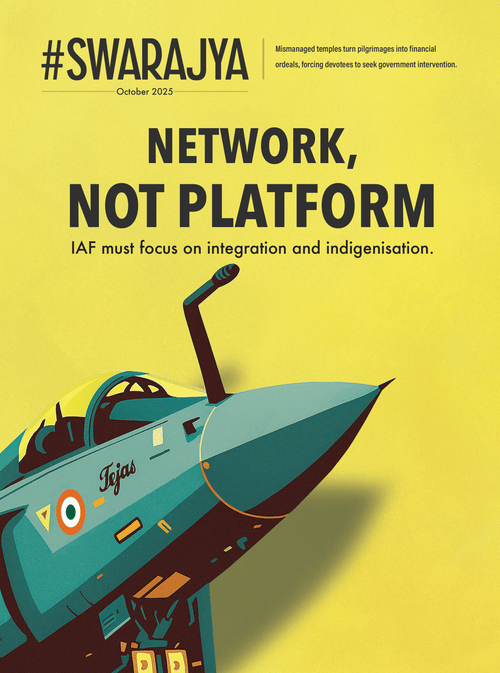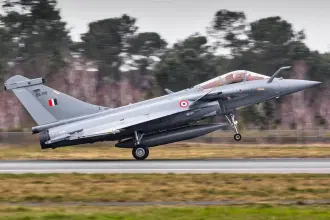Business
Grounding Drones: Why The Proposed Drone Bill Is Making The Industry Nervous
Ankit Saxena
Oct 29, 2025, 07:00 AM | Updated 10:43 AM IST
Save & read from anywhere!
Bookmark stories for easy access on any device or the Swarajya app.


India’s drone industry has transformed rapidly in recent years, driven by the country’s ambition to become a global drone hub by 2030.
Drones are now used widely across sectors such as land mapping, agriculture, infrastructure, and, crucially, strategic and defence applications, underscoring how vital the technology has become.
This growth has also been supported by government policies, which have come a long way from a blanket ban in 2014 to the more open Drone Rules, 2021, that encouraged innovation and expansion.
As more drones take to the skies, the government now plans to tighten its regulations. In September, the Ministry of Civil Aviation (MoCA) released the Draft Civil Drone (Promotion and Regulation) Bill, 2025, seeking feedback from stakeholders.
Once passed, it will become the main law governing Unmanned Aircraft Systems (UAS) under 500 kilograms, also replacing the existing Drone Rules, 2021.
The new Bill aims to build a stronger legal framework for drone operations. However, while the 2021 rules were seen as a liberal step that empowered Indian entrepreneurs, stakeholders argue that the 2025 draft reintroduces several compliance burdens.
Industry representatives, experts from related fields, and academicians from leading institutions such as the IITs and IISc have raised specific concerns.
These include changes to type certification requirements and a universal Unique Identification Number (UIN) mandate, the absence of research and development exemptions, and the strict criminalisation of certain offences with stronger penalties.
According to them, these shifts could have serious implications for India’s ambition of achieving self-reliance and becoming a global hub in drone technology by 2030.
Before exploring these concerns in detail, it is also important to look back at how India’s drone regulations have evolved over time.
How India’s Drone Regulations Evolved
India’s journey with drone regulation began in 2014, when the government imposed a blanket ban on civil drones. At the time, this move brought to a standstill any commercial or private use of drones across the country.
However, as interest and potential applications grew, the government began rethinking its approach.
In 2018, MoCA and the Directorate General of Civil Aviation (DGCA) launched Digital Sky, an online platform to manage unmanned aircraft operations in India. This also introduced the No Permission, No Takeoff (NPNT) system, ensuring that no drone could take flight without prior digital approval.
By 2020, the regulatory landscape evolved once again. In March 2021, the government introduced the UAS Rules, 2021, which expanded the licensing process and added more compliance layers.
These rules faced sharp criticism from industry players for being too restrictive and complex. Within just four months, the government acted on this feedback and replaced them with the more liberal Drone Rules, 2021.
This policy shift opened the skies to private participation, encouraging innovation beyond defence and surveillance, and simplifying approvals.
The government also supported this with reforms for domestic manufacturing, incentive schemes, import bans, and relaxed export norms.
What Changed After 2021
Since the introduction of the Drone Rules, 2021, India’s drone industry has seen a surge in investment and innovation.
“The updated regulations reduced the number of approval forms from 25 to just six, making compliance far more practical,” says Smit Shah, president of the Drone Federation of India.
The rules also removed the requirement for certificates of airworthiness, unique identification numbers, prior permissions, and remote pilot licences for R&D entities.
This environment gave startups the freedom to experiment and innovate and allowed multiple new ventures to work on drone design, assembly, subsystem development, and expanding drone services.
Furthermore, the conflict between India and Pakistan after the Pahalgam attack demonstrated the large-scale use and strategic importance of drones. It brought new attention to India’s drone industry and the need to build indigenous technology to become more self-reliant.
Yet, the momentum built over the last four years now faces new regulatory headwinds. The Civil Drone (Promotion and Regulation) Bill, 2025, is expected to be another step towards unifying drone regulations given this growth over the years.
However, based on the inputs of multiple stakeholders, it seems to bring back several compliance requirements that were removed just four years ago.
Concerns Over the 2025 Draft Bill
The initial question raised by many stakeholders is about the need and justification for a new law.
A drone service company official states that many are unable to understand the intent or expected outcomes of this proposed change, as no supporting brief has been released to explain why the existing rules must be replaced. “Further, if the focus shifts more toward punishment than progress, India could miss a valuable opportunity for growth.”
Moving forward, industry experts have flagged several regulatory concerns that could have effects across sectors.
Mandatory Type Certification and UIN
The draft Bill introduces a blanket requirement for type certification and a Unique Identification Number for all Unmanned Aircraft Systems, with no exemptions.
Unlike the Drone Rules, 2021, it does not differentiate between categories such as nano drones, model Remotely Piloted Aircraft Systems (RPAS), or self-assembled drones used for education or hobbies.
This change could significantly affect companies’ ability to design and innovate. Manufacturers would also need to tighten supply chain checks, ensure compliance for e-commerce sales, and take on direct liability in case of any violations.
Losing Focus on Innovation and Development
India’s drone industry is still developing, where innovation and research remain crucial for building domestic capabilities.
However, the mandatory UIN registration for every drone could bring research to a halt. According to academic inputs, “Prototypes developed in labs are often short-lived and evolve through multiple iterations. Applying full registration and certification requirements to every prototype would slow down or stop innovation altogether, while exposing researchers, students, and institutions to penalties.”
In effect, even drones flown in private or controlled spaces for recreational, educational, or research purposes would now require type certification and UIN registration, creating unnecessary compliance hurdles for students, innovators, and hobbyists.
As one industry expert puts it, “Instead of supporting research, the draft Bill, in its current form, curbs the freedom of R&D and might demotivate those who have been driving India’s drone ecosystem forward.”
The Bill also introduces stricter penalties, including jail time, for even minor violations. “The prospect of severe punishment for small errors creates fear rather than freedom among entrepreneurs,” Shah adds. “It will also discourage long-term investments when there are no clear pathways for experimentation.”
Criminalisation and Harsh Penalties
Offences that were earlier treated as civil violations are once again being criminalised. Under the Drone Rules, 2021, nearly 14 types of offences were listed, including operating, manufacturing, or selling drones without proper registration, insurance, or type certification.
Most of these carried fines of ₹1 lakh. Three serious offences of operating in restricted zones without permission or carrying arms, explosives, or hazardous materials involved imprisonment of up to two years.
The draft Bill introduces imprisonment of up to one year, along with fines, for all categories of offences, expanding the scope of criminal penalties across the board.
While strict penalties are justified for dangerous drone use, criminalising routine operational errors appears excessive. It also opens the door for arbitrary searches and seizures.
An official tells Swarajya, “This creates a risky environment for drone startups and service providers, as expensive drones could be grounded for minor infractions at any time.”
Industry bodies suggest that the existing rules already offer a strong framework for safety, accountability, and operational oversight, supported by other existing laws. Instead of introducing a new statute, the government could consider targeted amendments to improve enforcement under the current framework.
According to the Drone Federation of India, “The DGCA and law enforcement agencies should focus on visible action against illegal imports, unregistered operators, and deliberate misuse of drones in restricted zones.”
“For example, while over 50,000 operators are estimated to use drones illegally for aerial cinematography, only a handful of prosecutions have taken place so far. This has led to the growth of a grey market for permissions, often involving local enforcement officials.”
The Gaps the New Bill Fails to Address
The progress of the past decade has brought major attention to India’s drone revolution, but key reforms are still needed to realise its full potential for jobs, innovation, and economic growth.
The draft Bill does not clearly outline how it plans to continue the unfinished work of strengthening and expanding India’s Unmanned Aircraft Systems ecosystem.
Many such gaps that remain unattended have been pointed out as recommendations. These include long delays in type certification, difficulty in obtaining red and yellow zone permissions, lack of certification standards for long-range drone operations, rampant sale and use of illegally imported Chinese drones, weak enforcement by the police and DGCA against non-compliant operators, and confusion over claims and compensation, which are currently handled under the Motor Vehicles Act.
However, when it comes to certification timelines, the Bill removes the time limits previously set for the Certification Agency to grant approvals, while for all other issues, it shows no action or progress.
According to the Drone Federation of India, “Illegal imports from China continue despite the DGFT prohibition, and violators openly advertise with little action. Thus, while certification timelines exceed statutory limits, enforcement against unregistered or uncertified drone operations remains negligible.”
Beyond penalties, stakeholders point out that the draft still leaves several systemic gaps unaddressed. As discussions over the new drone Bill continue, stakeholders believe that the focus should shift to these existing gaps. This could be done through focused amendments and stronger implementation rather than by replacing the current framework with an entirely new law.





